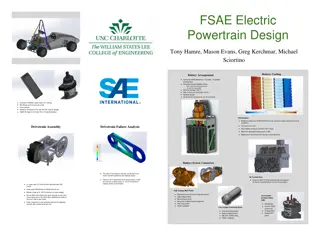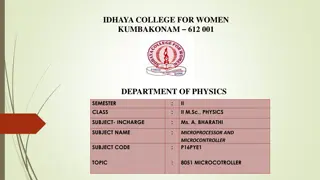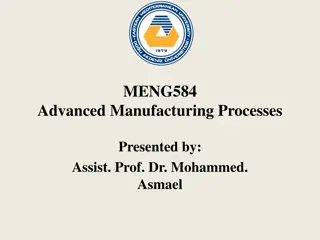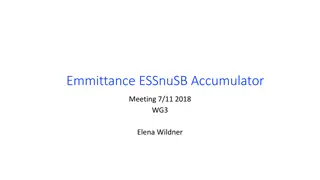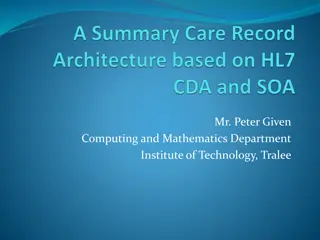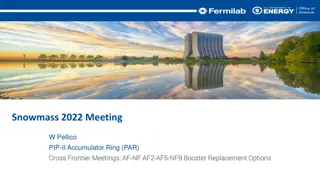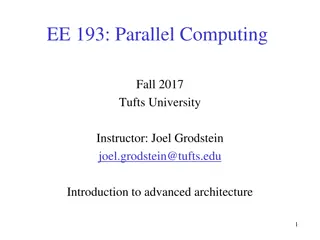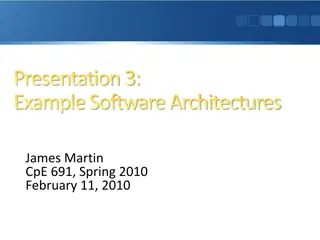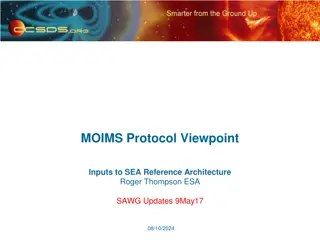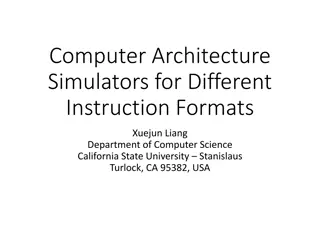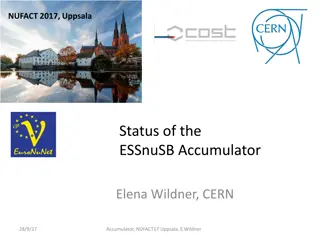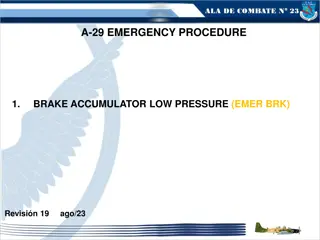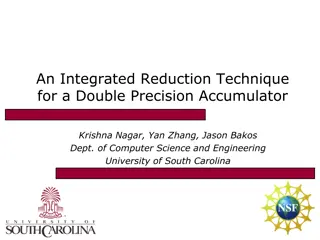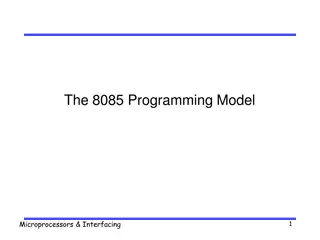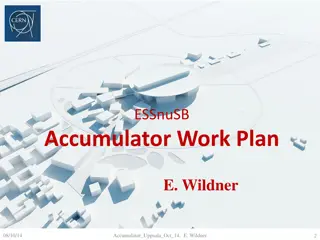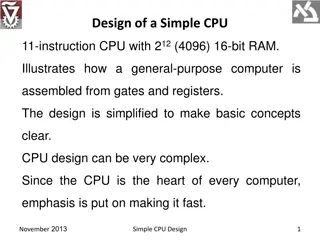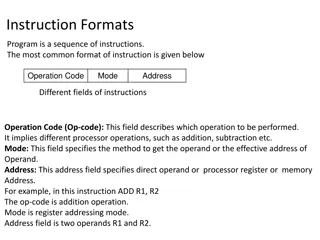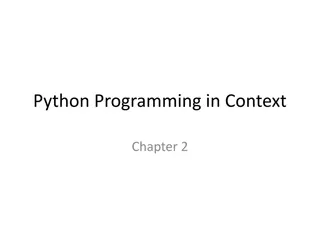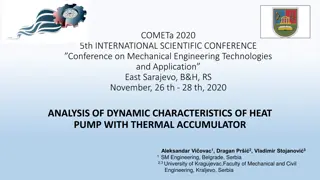Understanding Computer Organization and Architecture
A computer system is a programmable digital electronics device that processes data as per program instructions to provide meaningful output. It comprises hardware and software components, with hardware being the physical parts and software essential for driving the hardware. Computer organization fo
14 views • 71 slides
Decoupled SMO Architecture Overview
Develop flows showing interaction between SMO modules in the context of open-source architecture using OSC, ONAP, and other code. The objective is to align open-source work with O-RAN trends, improve synergy, reduce duplication, and provide feedback to O-RAN discussions. Related work includes Decoup
4 views • 27 slides
FSAE Electric Powertrain Design
In-depth overview of the FSAE electric powertrain design featuring battery cooling, arrangement, connectors, accumulator setup, and cooling system. The design includes Samsung 18650 batteries, premade Energus Battery Packs, aluminum radiator, air cooling fans, and high voltage main power braces. Det
2 views • 5 slides
Evolution of IBM System/360 Architecture and Instruction Set Architectures
The IBM System/360 (S/360) mainframe computer system family, introduced in 1964, revolutionized computing by offering forward and backward compatibility, a unified instruction set architecture (ISA), and a balance between scientific and business efficiency. The critical elements of this architecture
1 views • 18 slides
Overview of RF Architecture and Waveform Assumptions for NR V2X Intra-Band Operation
In the electronic meeting of 3GPP TSG-RAN-WG4, discussions were held on the RF architecture and waveform assumptions for NR V2X intra-band operation in band n79. Various options and recommendations were presented regarding RF architecture, antenna architecture, and waveform definitions for efficient
1 views • 7 slides
Understanding Computer Architecture and Organization
Computer architecture and organization are fundamental aspects of computing systems. Computer architecture focuses on the functional design and implementation of various computer parts, while computer organization deals with how operational attributes come together to realize the architectural speci
3 views • 40 slides
Common Software Architecture Anti-Patterns
Anti-patterns in software architecture are commonly occurring solutions to problems that lead to negative consequences. These arise due to insufficient knowledge or experience, misuse of design patterns, and lack of attention to evolving project architecture. Examples include Jumble, Stovepipe, Spag
1 views • 7 slides
PowerPC Architecture Overview and Evolution
PowerPC is a RISC instruction set architecture developed by IBM in collaboration with Apple and Motorola in the early 1990s. It is based on IBM's POWER architecture, offering both 32-bit and 64-bit processors popular in embedded systems. The architecture emphasizes a reduced set of pipelined instruc
2 views • 13 slides
Understanding the 8051 Microcontroller: Features, Registers, and Applications
A detailed overview of the 8051 microcontroller including its introduction, features, and registers. Explore how the 8051 is useful for small computing tasks, control applications, and its low power consumption. Learn about the various registers in the 8051 such as the accumulator, program counter,
0 views • 18 slides
Understanding Client-Server Architecture
Client-server architecture is a computing model where a central server hosts and manages resources and services for client computers over a network. There are different types of clients and servers, each with unique characteristics and roles. This architecture offers various advantages and disadvant
3 views • 15 slides
Understanding Water Jet Machining in Advanced Manufacturing Processes
Water jet machining (WJM) is a cutting-edge manufacturing process where a high-velocity water jet is used to erode materials rapidly. This method involves directing a high-pressure, high-velocity water jet onto the workpiece surface, forming cavities by eroding the material. The system includes comp
5 views • 42 slides
Digital Architecture for Supporting UNICEF's High-Impact Interventions
In an ideal scenario, the digital architecture for children would encompass systems such as Enterprise Architecture, Functional Architecture, and Solution Architecture to support UNICEF's high-impact interventions. It would involve integrated platforms for Health Information Exchange, Supply Chain M
1 views • 19 slides
Progress of Network Architecture Work in FG IMT-2020
In the Network Architecture Group led by Namseok Ko, significant progress has been made in defining the IMT-2020 architecture. The work has involved gap analysis, draft recommendations, and setting framework and requirements. Phase 1 focused on identifying 19 architectural gaps, such as demands for
1 views • 11 slides
Understanding Item-Based vs Index-Based Iteration in Programming
Exploring the differences between item-based and index-based iteration methods in programming, this content delves into the syntax, readability, and when to use each approach. It provides examples and scenarios to illustrate the use of these iteration methods and discusses the accumulator pattern an
0 views • 17 slides
Enhancing Particle Acceleration in Booster with Permanent Magnet Accumulator Ring
A permanent magnet accumulator ring could revolutionize the Booster facility, benefiting PIP-II/DUNE programs and advancing FNAL toward a large-scale DS program. By integrating the new 1 GeV line within the existing Booster to BNB enclosure, costs and timelines are significantly reduced. The proposa
1 views • 4 slides
ESSnuSB Emmittance Accumulator Meeting Summary
Meeting held on 7/11/2018 to discuss fixing emittances for the Emmittance.ESSnuSB.Accumulator. Various specifications and requirements were considered, including beam properties, target specifications, and beam distribution. Injection methods and pulsing structures for the Linac were also discussed,
0 views • 17 slides
A-29 Emergency Landing Gear Procedure
This emergency procedure outlines steps to follow in case of low pressure in the landing gear accumulator of the A-29 aircraft. It details actions to take for the emergency gear situation, including the response for low emergency brake accumulator pressure and the procedure to follow when the landin
0 views • 4 slides
Proposed Way Forward for Service-Oriented Architecture (SOA) in Space Missions
Proposed establishment of a Working Group by the CESG to develop a Service-Oriented Architecture (SOA) framework for space mission operations within the CCSDS. The focus includes identifying services, use cases, architecture definitions, and business cases to enhance CCSDS-wide interoperability and
0 views • 7 slides
Introduction to Y86 Instruction Set Architecture
Y86 Instruction Set Architecture is a simplified pseudo-language based on x86 (IA-32) architecture. It involves implementing the Fetch-Decode-Execute cycle, where instructions are fetched from memory, decoded, and executed. The Y86 ISA offers a simpler set of instructions and formats compared to x86
0 views • 25 slides
Enhancing Healthcare Data Sharing with Service-Oriented Architectures
This paper explores how Service-Oriented Architectures (SOA) can be integrated with the HL7 Clinical Document Architecture to facilitate the sharing of Summary Care Records between healthcare information systems. It highlights the benefits of a federated architecture based on SOA and coding standard
0 views • 51 slides
Exploring Modern Architecture Trends: Expressionism and Bauhaus Movement
Delve into the world of modern architecture trends, focusing on Expressionist architecture in Europe during the early 20th century and the influential Bauhaus movement in Germany. Expressionist architecture emphasized emotional effects through distorted forms inspired by nature, while the Bauhaus sc
0 views • 10 slides
Overview of 5G System Architecture and User Plane Functionality
This content showcases various aspects of 5G system architecture, including system handover, non-roaming architecture, service-based architecture, and user plane functionality. It delves into the control plane functions, user plane functions, and core network endpoints of the 5G network. The images
0 views • 49 slides
Snowmass 2022 Meeting - PIP-II Accumulator Ring (PAR)
Snowmass 2022 Meeting presentation discusses an opportunity for a storage ring utilizing PIP-II capabilities to support DUNE power ramp up and FNAL physics program. The talk outlines the potential benefits and implications of this proposal in the field of particle physics.
0 views • 25 slides
Understanding Client/Server Computing Architecture
Client/Server Computing architecture separates clients and servers over a network, allowing for file sharing, resource allocation, and service requests. Clients initiate services from servers, with transparent server locations and message-passing transactions. Systems with C/S architecture include f
0 views • 18 slides
Understanding Memory Hierarchy and Different Computer Architecture Styles
Delve into the concepts of memory hierarchy, cache optimizations, RISC architecture, and other architecture styles in embedded computer architecture. Learn about Accumulator and Stack architectures, their characteristics, advantages, and example code implementations. Explore the differences between
0 views • 52 slides
Understanding Advanced Computer Architecture in Parallel Computing
Covering topics like Instruction-Set Architecture (ISA), 5-stage pipeline, and Pipelined instructions, this course delves into the intricacies of advanced computer architecture, with a focus on achieving high performance by optimizing data flow to execution units. The course provides insights into t
0 views • 12 slides
Software Architecture Design for Document Filter System: A Case Study
This presentation delves into the software architecture design and implementation of a Document Filter System (DFS) aimed at efficiently finding relevant information. It discusses the architecture's effectiveness in supporting diverse applications, multilingual document searching, complex query func
0 views • 33 slides
Exploring Math History and Problem-Solving Techniques
Delve into the historical roots of mathematics with discussions on Archimedes' and Leibniz's approximations, culminating in John Wallis' symbolic contributions. Follow the problem-solving steps outlined by George Pólya and learn to apply the Accumulator Pattern to mathematical challenges. Discover
0 views • 26 slides
MOIMS Protocol Viewpoint for SEA Reference Architecture Updates
This content describes the MOIMS Protocol Viewpoint inputs to the SEA Reference Architecture updates by Roger Thompson from ESA SAWG. It includes details about the graphical conventions, data store elements, organizational domains, network layers, communications protocols, and space communications c
0 views • 21 slides
Computer Architecture Simulators for Different Instruction Formats
Development of computer simulators to address limitations in the MARIE machine simulator, enabling comparison of various computer architectures through the implementation of different instruction formats. The simulators allow for programming diverse computer processors using assembly languages, with
0 views • 65 slides
Challenges and Design of High-Intensity Accumulator for Neutrino Experiments
The presentation discusses the challenges faced in designing an accumulator for high-intensity particle beams in neutrino experiments at ESS Lund, with a focus on beam loss management, injection efficiency, and intense beam physics issues. The design considerations include beam holding capacity, bea
0 views • 30 slides
Emergency Procedure for Brake Accumulator Low Pressure in A-29 Aircraft
This emergency procedure outlines the steps to address low pressure in the brake accumulator of the A-29 aircraft. It explains the implications of low pressure, the actions to take, and the importance of using chocks in the aircraft parking area. The procedure ensures the safe braking of the aircraf
0 views • 4 slides
Integrated Reduction Technique for Double Precision Accumulator
An integrated reduction technique for a double precision accumulator is discussed in the research paper by Krishna Nagar, Yan Zhang, and Jason Bakos from the University of South Carolina. The paper addresses issues related to double precision accumulation in kernels targeted for acceleration, presen
1 views • 25 slides
Understanding the 8085 Microprocessor Programming Model
The 8085 microprocessor, made by Intel, features general purpose registers, an accumulator, flag register, stack pointer, and program counter. The programming model includes ALU operation, flag flip-flops, and different instruction formats and operand types for executing tasks efficiently.
0 views • 13 slides
ESSnuSB Accumulator Work Plan Update
ESSnuSB project involves optimizing the accumulator system for efficient neutron extraction. Proposed changes include pulsing one accumulator four times and adjusting bumpers for faster injection. The linac pulsing frequency and fill time considerations are also discussed. The accumulator lattice de
0 views • 32 slides
Illustrated Design of a Simplified CPU with 16-bit RAM
Demonstrates the design of a basic CPU with 11 instructions and 4096 16-bit RAM, showcasing the assembly of a general-purpose computer using gates and registers. The CPU comprises 8 key registers for various functions, employing a sequential circuit for instruction execution. The machine language pr
0 views • 31 slides
Central Benefits Annual Reconciliation Updates and Reporting Strategy
Updates and revisions related to the annual reconciliation process have been outlined, including the introduction of new accumulator and earnings codes, adjustments in December 2018 remittance reporting, and details on STAR and WRS reporting process. These changes aim to enhance accuracy and ensure
0 views • 18 slides
Understanding Different Instruction Formats in Computing
Instruction formats in computing include one-address, two-address, three-address, and zero-address instructions, each with specific ways of specifying operations and operands. One-address instructions utilize an implied accumulator register, while two-address and three-address instructions allow for
0 views • 18 slides
Exploring Python Programming in Context Chapter 2
In this chapter, we delve into how computers can solve real problems using Python. We explore numeric expressions, variables, assignments, the accumulator pattern, and the math library. Additionally, we look into simple iteration patterns, selection statements, and using random numbers to estimate a
0 views • 31 slides
Analysis of Dynamic Characteristics of Heat Pump with Thermal Accumulator
This study presents an analysis of the dynamic characteristics of a heat pump system integrated with a thermal accumulator. Experimental data and analytical results are compared, demonstrating the performance of the system and its control mechanisms. The research provides insights into the operation
0 views • 14 slides


